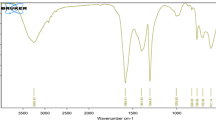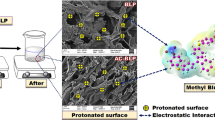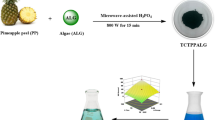Abstract
This work reported the adsorption of Cr (VI) ions and acid orange 142 dye onto dead fungal biomass. The mycelium of Aspergillus ustus (MAU) was successfully cultured, grown, extracted and utilized as an efficient adsorbent. The extensive characterization studies of the as-prepared MAU sample were achieved with the Fourier Transform Infrared Spectrophotometer (FTIR), X-ray diffraction (XRD), Scanning Electron Microscopy (SEM) and Energy Dispersive X-ray (EDX) analyses. Process variables' effects were conducted in the following ranges: pH (3.0–6.0), contact time (0–120 min) and MAU dosage (0.5–5.0 g/L). The FTIR studies revealed that the amino, hydroxyl, and acetamide functional groups on the MAU provided veritable sites for Cr (VI) and AO142 binding. Optimum Cr (VI) uptake was however recorded at 80 min at pH 5.0, while that of AO142 dye was established at 120 min and pH 3.0. The Temkin and pseudo-second-order model aptly described the experimental isotherm and kinetic data. Hence, the MAU was efficient at adsorbing Cr (VI) and AO142 dye from an aqueous solution, but with a higher adsorption capacity for the AO142 molecules.













Similar content being viewed by others
Data Availability
All data generated or analyzed during this study are included in this published article.
References
Onuzulike CM, Aniagor CO, Modekwe GO, Ejimofor MI, Menkiti MC (2022) Remediation of Lead Ion Contaminated Stream Using Biosurfactant-Functionalized Mesoporous Activated Carbon. Chemistry Africa. https://doi.org/10.1007/s42250-022-00316-5
Babarinde A, Babalola JO, Adegoke J, Osundeko AO, Olasehinde S, Omodehin A, Nurhe E (2013) Biosorption of Ni (II), Cr (III), and Co (II) from solutions using Acalypha hispida leaf: kinetics, equilibrium, and thermodynamics. J Chem. Article ID 460635. https://doi.org/10.1155/2013/460635
Jing X, Cao Y, Zhang X, Wang D, Wu X, Xu H (2011) Biosorption of Cr (VI) from simulated wastewater using a cationic surfactant modified spent mushroom. Desalination 269(1–3):120–127
Saha B, Orvig C (2010) Biosorbents for hexavalent chromium elimination from industrial and municipal effluents. Coord Chem Rev 254(23–24):2959–2972
Asfaw TB, Tadesse TM, Ewnetie AM (2017) Determination of total chromium and chromium species in Kombolcha tannery wastewater, surrounding soil, and lettuce plant samples, South Wollo. Ethiopia Adv Chem 2017:1–7
Mohamed LA, Aniagor CO, Hashem A (2021) Isotherms and kinetic modelling of mycoremediation of hexavalent chromium contaminated wastewater. Clean Eng Technol 4:100192
Menkiti MC, Aniagor CO, Onuzulike CM, Ejimofor MI, Okonkwo SS (2022) Chromium adsorption from petroleum refinery wastewater using biocomposites. Results Surf Interfaces 8:100064. https://doi.org/10.1016/j.rsurfi.2022.100064
Kalsoom A, Batool R (2020) Biological and Nonbiological Approaches for Treatment of Cr (VI) in Tannery Effluent. Emerging Eco-friendly Green Technologies for Wastewater Treatment. Springer, pp 147–170
Sankhla MS, Kumar R, Prasad L (2019) Distribution and contamination assessment of potentially harmful element chromium in water. International Medico-Legal Reporter Journal, 2 (3). https://doi.org/10.2139/ssrn.3492307
Jeřábková J, Tejnecký V, Borůvka L, Drábek O (2018) Chromium in anthropogenically polluted and naturally enriched soils: a review. Sci Agric Bohem 49(4):297–312
Kumar A, Dixit U, Singh K, Gupta SP, Beg MSJ (2021) Structure and properties of dyes and pigments, in dyes and pigments-novel applications and waste treatment. IntechOpen. https://doi.org/10.5772/intechopen.97104
Hashem A, Aniagor CO, Farag S, Abou-Okeil AA, Aly AA, Amr A (2022) Lepidium sativum Seed Powder: A Novel Biosorbent for Acid Orange 142 Dye Uptake. Environ Process 9(4):1–20
Lellis B, Fávaro-Polonio CZ, Pamphile JA, Polonio JC (2019) Effects of textile dyes on health and the environment and bioremediation potential of living organisms. Biotechnol Res Innov 3(2):275–290
Rangabhashiyam S, Anu N, Nandagopal MG, Selvaraju N (2014) Relevance of isotherm models in biosorption of pollutants by agricultural byproducts. J Environ Chem Eng 2(1):398–414
Baral A, Engelken RD (2002) Chromium-based regulations and greening in metal finishing industries in the USA. Environ Sci Policy 5(2):121–133
Hashem A, Aniagor CO, Abdel-Halim E, Amr A, Farag S, Aly A (2022) Instrumental characteristics and acid blue 193 dye sorption properties of novel lupine seed powder. Clean Chem Eng 2:100011. https://doi.org/10.1016/j.clce.2022.100011
Hashem A, Aniagor C, Hussein D, Farag S (2021) Application of novel butane-1, 4-dioic acid-functionalized cellulosic biosorbent for aqueous cobalt ion sequestration. Cellulose 28(6):3599–3615
Hashem A, Aniagor C, Taha GM, Fikry M (2021) Utilization of low-cost sugarcane waste for the adsorption of aqueous Pb (II): kinetics and isotherm studies. Curr Res Green Sustain Chem 4:100056
Kabbout R, Taha S (2014) Biodecolorization of textile dye effluent by biosorption on fungal biomass materials. Phys Procedia 55:437–444
Sharma KR, Naruka A, Raja M, Sharma RK (2022) White rot fungus mediated removal of mercury from wastewater. Water Environ Res 94(7):e10769
Mo J, Liu Y, Gao X, Zhou S, Deng Y, Ke Y, Peng L, Li H, Chen S, Long J (2022) Potential application of Fusarium fungal strains (Fusarium sp. FP, Arthrinium sp. FB, and Phoma sp. FR) for removal of Tl (I) ions from water. Environ Sci Pollut Res 29:46049–46063. https://doi.org/10.1007/s11356-022-18791-1
Mohamed LA, Aniagor CO, Taha GM, Abou-Okeil A, Hashem A (2021) Mechanistic investigation of the mass transfer stages involved during the adsorption of aqueous lead onto Scopulariopsis brevicompactum fungal biomass. Environ Challenges 5:100373
Almeida E, Corso C (2019) Decolorization and removal of toxicity of textile azo dyes using fungal biomass pelletized. Int J Environ Sci Technol 16(3):1319–1328
Hashem A, Aniagor CO, Morsy OM, Abou-Okeil A, Aly A (2022) Apricot seed shell: an agro-waste biosorbent for acid blue193 dye adsorption. Biomass Convers Biorefinery. https://doi.org/10.1007/s13399-022-03272-9
Wiryawan A, Retnowati R, Burhan P, Syekhfani S (2018) Method of analysis for determination of the chromium (Cr) species in water samples by spectrophotometry with diphenylcarbazide. J Environ Eng Sustain Technol 5(1):37–46
Ho Y-S, McKay G (1999) Pseudo-second order model for sorption processes. Process Biochem 34(5):451–465
Aniagor C, Menkiti M (2018) Kinetics and mechanistic description of adsorptive uptake of crystal violet dye by lignified elephant grass complexed isolate. J Environ Chem Eng 6(2):2105–2118
Leaist DG, Hao L (1994) Simultaneous measurement of mutual diffusion and intradiffusion by Taylor dispersion. J Phys Chem 98(17):4702–4706
Al-Ghouti MA, Da’ana DA (2020) Guidelines for the use and interpretation of adsorption isotherm models: A review. J Hazard. Mater 93:122383. https://doi.org/10.1016/j.jhazmat.2020.122383
Menkiti M, Aniagor C (2018) Parametric studies on descriptive isotherms for the uptake of crystal violet dye from aqueous solution onto lignin-rich adsorbent. Arab J Sci Eng 43(5):2375–2392
Ho Y, Porter J, McKay G (2002) Equilibrium isotherm studies for the sorption of divalent metal ions onto peat: copper, nickel and lead single component systems. Water Air Soil Pollut 141(1–4):1–33
Aniagor CO, Abdel-Halim ES, Hashem A (2021) Evaluation of the aqueous Fe (II) ion sorption capacity of functionalized microcrystalline cellulose. J Environ Chem Eng 9(4):105703
Hashem A, Aniagor CO, Nasr MF, Abou-Okeil A (2021) Efficacy of treated sodium alginate and activated carbon fibre for Pb (II) adsorption. Int J Biol Macromol 176:201–216
Cristiano E, Hu Y-J, Siegfried M, Kaplan D, Nitsche H (2011) A comparison of point of zero charge measurement methodology. Clays Clay Miner 59(2):107–115
Abdel-Mohsen AM, Frankova J, Abdel-Rahman RM, Salem AA, Sahffie NM, Kubena I, Jancar J (2020) Chitosan-glucan complex hollow fibers reinforced collagen wound dressing embedded with aloe vera. II. Multifunctional properties to promote cutaneous wound healing. Int J Pharm 582:119349
Abdel-Mohsen AM, Jancar J, Massoud D, Fohlerova Z, Elhadidy H, Spotz Z, Hebeish A (2016) Novel chitin/chitosan-glucan wound dressing: Isolation, characterization, antibacterial activity and wound healing properties. Int J Pharm 510(1):86–99
Beran K, Holan Z, Baldrián J (1972) The chitin-glucan complex in Saccharomyces cerevisiae. I. IR and x-ray observations. Folia Microbiol (Praha) 17(5):322–30
Abdel-Rahman RM, Vishakha V, Kelnar I, Jancar J, Abdel-Mohsen AM (2022) Synergistic performance of collagen-g-chitosan-glucan fiber biohybrid scaffold with tunable properties. Int J Biol Macromol 202:671–680
Zhou J, Liu LL, Cao LL, Stephan DW (2018) Nitrogen-Based Lewis Acids: Synthesis and Reactivity of a Cyclic (Alkyl)(Amino) Nitrenium Cation. Angew Chem Int Ed 57(13):3322–3326
Brunauer S, Emmett PH, Teller E (1938) Adsorption of gases in multimolecular layers. J Am Chem Soc 60(2):309–319
Zdravkov B, Čermák J, Šefara M, Janků J (2007) Pore classification in the characterization of porous materials: A perspective. Open Chem 5(2):385–395
Mays T (2007) A new classification of pore sizes. Stud Surf Sci Catal 160(Characterization of Porous Solids VII):57–62
Hashem A, Okeil A, Fikry M, Aly A, Aniagor C (2021) Isotherm and kinetics parametric studies for aqueous Hg (II) uptake onto N-[2-(methylamino) ethyl] ethane-1, 2-diaminated acrylic fibre. Arab J Sci Eng 46(7):6703–6714
Li Y, Shan S, Yang R, Gai X, Mao J, Huang N, Tou Y, Meas A (2016) Preparation of bamboo biochars by low-temperature hydrothermal method and its adsorption of organics. Trans Chinese Soc Agric Eng 32(24):240–247
Aniagor CO, Afifi M, Hashem A (2021) Modelling of basic blue-9 dye sorption onto hydrolyzed polyacrylonitrile grafted starch composite. Carbohydrate Polymer Technol App 2:100141
Ohale PE, Onu CE, Nwabanne JT, Aniagor CO, Okey-Onyesolu CF, Ohale NJ (2022) A comparative optimization and modeling of ammonia–nitrogen adsorption from abattoir wastewater using a novel iron-functionalized crab shell. Appl Water Sci 12(8):1–27
Aniagor CO, Afifi M, Hashem A (2021) Rapid and efficient uptake of aqueous lead pollutant using starch-based superabsorbent hydrogel. Polym Bull. https://doi.org/10.1007/s00289-021-03817-4
Aniagor CO, Taha GM, Badawy SM, El-Naggar ME, Hashem A (2022) Preparation of a novel acrylic fiber-based hydrogel and its utilization for the removal of aqueous lead ion. J Market Res 18:1450–1459
Alkurdi SS, Al-Juboori RA, Bundschuh J, Bowtell L, Marchuk A (2021) Inorganic arsenic species removal from water using bone char: A detailed study on adsorption kinetic and isotherm models using error functions analysis. J Hazard Mater 405:124112
Azizian S, Haerifar M, Basiri-Parsa J (2007) Extended geometric method: a simple approach to derive adsorption rate constants of Langmuir-Freundlich kinetics. Chemosphere 68(11):2040–2046
Chowdhury S, Saha P (2010) Sea shell powder as a new adsorbent to remove Basic Green 4 (Malachite Green) from aqueous solutions: Equilibrium, kinetic and thermodynamic studies. Chem Eng J 164(1):168–177
Igwegbe CA, Aniagor CO, Oba SN, Yap P-S, Iwuchukwu FU, Liu T, de Souza EC, Ighalo JO (2021) Environmental protection by the adsorptive elimination of acetaminophen from water: a comprehensive review. J Ind Eng Chem 104:117–135
Aniagor CO, Menkiti MC (2020) Relational description of an adsorption system based on isotherm, adsorption density, adsorption potential, hopping number and surface coverage. Sigma J Eng Nat Sci 38(3):1073–1098
Chen X, Hossain MF, Duan C, Lu J, Tsang YF, Islam MS, Zhou Y (2022) Isotherm models for adsorption of heavy metals from water-A review. Chemosphere 307:135545. https://doi.org/10.1016/j.chemosphere.2022.135545
Majd MM, Kordzadeh-Kermani V, Ghalandari V, Askari A, Sillanpää M (2021) Adsorption isotherm models: A comprehensive and systematic review (2010–2020). Sci Total Environ 812:151334. https://doi.org/10.1016/j.scitotenv.2021.151334
Podder M, Majumder C (2019) Bacteria immobilization on neem leaves/MnFe2O4 composite surface for removal of As (III) and As (V) from wastewater. Arab J Chem 12(8):3263–3288
Ighalo JO, Omoarukhe FO, Ojukwu VE, Iwuozor KO, Igwegbe CA (2022) Cost of adsorbent preparation and usage in wastewater treatment: A review. Clean Chem Eng 3:100042. https://doi.org/10.1016/j.clce.2022.100042
Dhankhar R, Hooda A (2011) Fungal biosorption–an alternative to meet the challenges of heavy metal pollution in aqueous solutions. Environ Technol 32(5):467–491
Puranik P, Paknikar K (1997) Biosorption of lead and zinc from solutions using Streptoverticillium cinnamoneum waste biomass. J Biotechnol 55(2):113–124
O’mahony T, Guibal E, Tobin J (2002) Reactive dye biosorption by Rhizopus arrhizus biomass. Enzyme Microbial Technol 31(4):456–463
Baskar AV, Bolan N, Hoang SA, Sooriyakumar P, Kumar M, Singh L, Jasemizad T, Padhye LP, Singh G, Vinu A (2022) Recovery, regeneration and sustainable management of spent adsorbents from wastewater treatment streams: A review. Sci Total Environ 822:153555. https://doi.org/10.1016/j.scitotenv.2022.153555
Gupta S, Sireesha S, Sreedhar I, Patel CM, Anitha K (2020) Latest trends in heavy metal removal from wastewater by biochar based sorbents. J Water Process Eng 38:101561
Won SW, Yun Y-S (2008) Biosorptive removal of Reactive Yellow 2 using waste biomass from lysine fermentation process. Dyes Pigm 76(2):502–507
Prasad S, Yadav KK, Kumar S, Gupta N, Cabral-Pinto MM, Rezania S, Radwan N, Alam J (2021) Chromium contamination and effect on environmental health and its remediation: A sustainable approaches. J Environ Manage 285:112174
Dhillon GS, Rosine GML, Kaur S, Hegde K, Brar SK, Drogui P, Verma M (2017) Novel biomaterials from citric acid fermentation as biosorbents for removal of metals from waste chromated copper arsenate wood leachates. Int Biodeterior Biodegradation 119:147–154
Igwegbe CA, Oba SN, Aniagor CO, Adeniyi AG, Ighalo JO (2021) Adsorption of ciprofloxacin from water: a comprehensive review. J Ind Eng Chem 93:57–77
Saravanan A, Karishma S, Kumar PS, Varjani S, Yaashikaa P, Jeevanantham S, Ramamurthy R, Reshma B (2021) Simultaneous removal of Cu (II) and reactive green 6 dye from wastewater using immobilized mixed fungal biomass and its recovery. Chemosphere 271:129519
Saravanan A, Sundararaman T, Jeevanantham S, Karishma S, Kumar PS, Yaashikaa P (2020) Effective adsorption of Cu (II) ions on sustainable adsorbent derived from mixed biomass (Aspergillus campestris and agro waste): optimization, isotherm and kinetics study. Groundw Sustain Dev 11:100460
Sundararaju S, Manjula A, Kumaravel V, Muneeswaran T, Vennila T (2020) Biosorption of nickel ions using fungal biomass Penicillium sp. MRF1 for the treatment of nickel electroplating industrial effluent. Biomass Convers Biorefin 12:1059–1068. https://doi.org/10.1007/s13399-020-00679-0
Karthik V, Kumar PS, Harsha Vardhan K, Saravanan K, Nithyakala N (2022) Adsorptive behaviour of surface tailored fungal biomass for the elimination of toxic dye from wastewater. Int J Environ Anal Chem 102(16):4710–4725
Saravanan A, Kumar PS, Govarthanan M, George CS, Vaishnavi S, Moulishwaran B, Kumar SP, Jeevanantham S, Yaashikaa P (2021) Adsorption characteristics of magnetic nanoparticles coated mixed fungal biomass for toxic Cr (VI) ions in aquatic environment. Chemosphere 267:129226
Funding
There was no external funding for the study.
Author information
Authors and Affiliations
Contributions
• L.A. Mohamed: Experimentation, Formal analyses, Data curation.
• Chukwunonso O. Aniagor: Conceptualization, Data curation, Supervision, Writing – Original draft, Writing – Review and editing.
• A.A. Aly: Experimentation, Formal analyses, Data curation.
• A. Hashem: Project administration, Data curation, Supervision, Writing – Review and editing.
Corresponding authors
Ethics declarations
Competing Interests
The authors declare no competing interests.
Ethical Approval
Not applicable.
Conflict of Interest
The authors declare that there are no conflicts of interest and there exist no relationships or activities that could appear to have influenced the submitted work.
Additional information
Publisher's Note
Springer Nature remains neutral with regard to jurisdictional claims in published maps and institutional affiliations.
Rights and permissions
Springer Nature or its licensor (e.g. a society or other partner) holds exclusive rights to this article under a publishing agreement with the author(s) or other rightsholder(s); author self-archiving of the accepted manuscript version of this article is solely governed by the terms of such publishing agreement and applicable law.
About this article
Cite this article
Mohamed, L.A., Aniagor, C.O., Aly, A.A. et al. Removal of Chromium (VI) and Acid Orange 142 dye from Contaminated Wastewater using Bio-waste Mycelium of Aspergillus Ustus: Extraction, Isotherms and Kinetics Studies. Water Conserv Sci Eng 8, 31 (2023). https://doi.org/10.1007/s41101-023-00206-y
Received:
Revised:
Accepted:
Published:
DOI: https://doi.org/10.1007/s41101-023-00206-y




